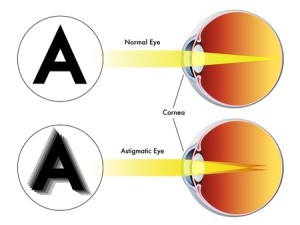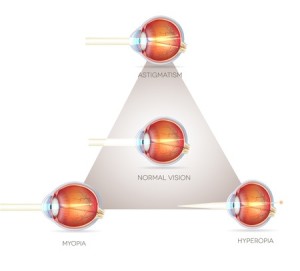Refractive Surgery
 Patients with a refractive error, such as nearsightedness (myopia), farsightedness (hyperopia), presbyopia or astigmatism, can benefit from refractive surgery as a method for correcting or improving their vision. There are different options of surgical procedures for correcting or adjusting your eye’s focusing ability. These include reshaping the cornea (the clear, round dome at the front of your eye), or implanting a lens inside your eye (refractive lens exchange). The most common type of refractive surgery is LASIK (laser-assisted in situ keratomileusis), which uses a laser to reshape the cornea.
Patients with a refractive error, such as nearsightedness (myopia), farsightedness (hyperopia), presbyopia or astigmatism, can benefit from refractive surgery as a method for correcting or improving their vision. There are different options of surgical procedures for correcting or adjusting your eye’s focusing ability. These include reshaping the cornea (the clear, round dome at the front of your eye), or implanting a lens inside your eye (refractive lens exchange). The most common type of refractive surgery is LASIK (laser-assisted in situ keratomileusis), which uses a laser to reshape the cornea.
What is Refractive Lens Exchange?
 Refractive Lens Exchange (RLE) is also referred to as clear lens extraction or presbyopic lens correcting intraocular surgery. RLE is very similar to cataract surgery, and is regarded as a relatively safe and effective procedure. Like many other types of refractive surgery, including LASIK eye surgery, Refractive Lens Exchange corrects nearsightedness and farsightedness. The patient’s vision correction is achieved with the insertion of a lens implant known as an IOL.
Refractive Lens Exchange (RLE) is also referred to as clear lens extraction or presbyopic lens correcting intraocular surgery. RLE is very similar to cataract surgery, and is regarded as a relatively safe and effective procedure. Like many other types of refractive surgery, including LASIK eye surgery, Refractive Lens Exchange corrects nearsightedness and farsightedness. The patient’s vision correction is achieved with the insertion of a lens implant known as an IOL.
Refractive Lens Exchange is an effective alternative for an ophthalmologist to utilize when lasers are not a good option due to the patient’s specific vision problems. RLE may be useful if a patient has extremely thin corneas, which would preclude laser surgery.
 Advantages of Refractive Lens Exchange
Advantages of Refractive Lens Exchange
- Reduces the dependence on glasses and contact lenses
- Significant improvement in near, intermediate and distance vision
- Rapid recovery after surgery
- Excellent results without the use of a laser
- Eliminates the need for cataract surgery in the future





